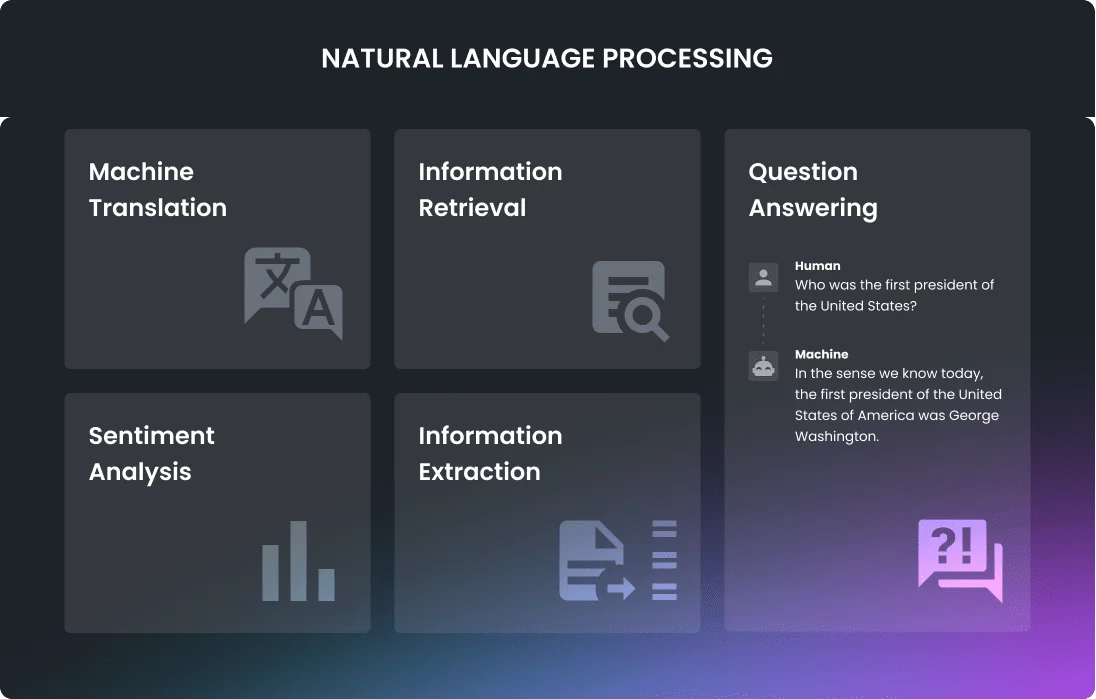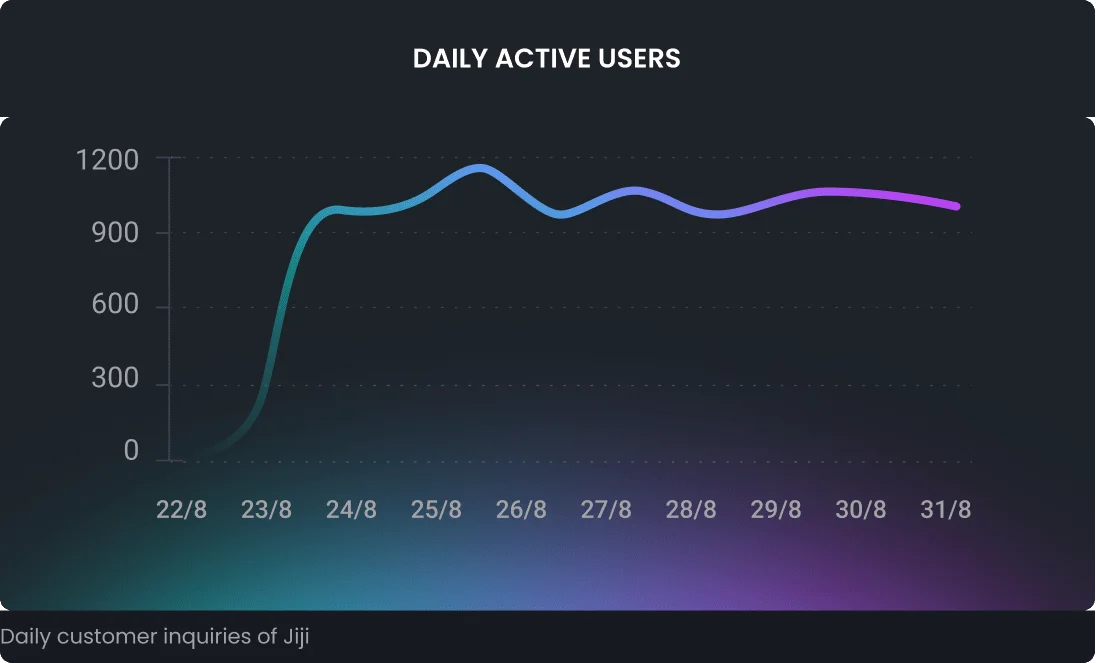Natural Language Processing (NLP) is a new field of study that has appeared to become a new trend since AI bots were released and integrated so deeply into our lives. The more these intelligent robots become popular and in demand, the greater the need to develop AI technologies.

The key feature of chatbots is NLP technologies, which give artificial intelligence an advantage. AI’s neuro-linking technology is still in its early stages, and there are numerous challenges to overcome along the way of its development. In this article, we’ll provide 7 examples of major NLP problems chatbot developers face today and why this technology development is important for modern-day business.
The importance of Natural Language Processing
Nowadays, NLP transforms how we interact with high-tech. Similarly, the internet has changed the entire way of life or smartphones have forever integrated into our daily routine, now the time when NLP technologies tend to simplify our daily routine tasks we do.
The potential the AI technologies carry can influence how we communicate, as an example, we could talk with other people who speak different languages without any problems. Another direction where artificial intelligence may improve our lives is in customer support, fintech or analysis of big data. It is connected with the ability of AI language models to process large amounts of information and understand human speech. Just imagine a human-like droid answering people’s FAQs or issuing receipts for medical use.
Famous people and companies are fighting to become a new monopoly amongst AIs. Google is presenting its “Bard,” Elon Musk is not afraid of artificial intelligence, as he was just a year ago. Now Musk is announcing his attempt to create the best bot the world’s ever seen. OpenAI announced just recently the new generation of chatbots — GPT-4. And the further the race goes, the bigger thing AI becomes. The global сhatbot market is projected to reach $42 billion by 2032, growing at 8.5 times from 2022 to 2032, according to the research of Market.us company. This growth underscores the increasing demand for and applicability of NLP across diverse industries.

To make use of AI’s full potential, the developers are currently working on overcoming NLP problems and improving human language understanding. Because these are the technologies which are powering AI — they are called Natural Language Processing mechanisms.
7 major NLP challenges
Natural Language Processing (NLP) is an area of computer science devoted to easing communication between people and computers via the use of natural language. Although the sector has made strides in recent years, various problems need to be overcome in order to improve the accuracy of language systems. The goal of this essay is to look at some of the most common Natural Language Processing challenges and propose possible solutions and current research to overcome these obstacles.
Natural Language Processing is an area of computer science focused on leveraging natural language in human-computer communication. Although NLP has made significant progress lately, there are still many challenges to be addressed before it can be considered accurate and efficient. Our essay will go through some of the most significant Natural Language Processing problems the AI system confronts.
- Vagueness
One of the most difficult NLP challenges is dealing with ambiguity. Human language is often filled with words or phrases that may mean a variety of things, depending on the context. To accurately analyze and interpret the intended meaning, Natural Language Processing algorithms must detect the context in which the word or phrase is being used. To effectively analyze and grasp the intended goal, NLP algorithms must be able to determine the right context in which the word or phrase is being used.
- Idiomatic expressions
Idiomatic expressions are words or phrases implying something different from their literal meaning. For example, the phrase “break a leg” is occasionally used to mean “good luck.” Because idiomatic phrases often need extensive cultural and linguistic understanding, processing them is a significant NLP problem.
- Sarcasm and irony
The intended meanings of irony and sarcasm differ from their literal readings. Recognizing these sentences in NLP systems is difficult since they need an understanding of the context. NLP problem occurs because systems must distinguish between literal and metaphorical language, as well as understand nuanced indicators that display irony and sarcasm.

- Syntax vs. Semantics
Another Natural Language Processing problem is to identify syntax and semantics. Although NLP systems have made significant progress in parsing syntactic structures, understanding the semantics of a text remains difficult because NLP algorithms must be able to discern the intended meaning of words and phrases in context.
- Language transition
Language is alive and active. Users learn new words, phrases, and expressions on a daily basis, while others forget. It is challenging for Natural Language Processing systems to stay current and handle new language advances appropriately. It is challenging to keep up with the development since NLP algorithms must constantly update their language models.
- Several languages
Because there are over 7,000 languages spoken worldwide, developing NLP systems that can efficiently process and interpret them is a huge problem. Understanding the syntax, rules, and cultural characteristics is required for developing multilingual NLP systems. They must be able to identify idiosyncrasies in each language, and ensure accurate text translation. Meeting this difficulty requires knowledge of machine-learning algorithms as well as a substantial quantity of training data.
- Inadequate training data
Natural Language Processing advancement needs much annotated data, but it actually requires lots of time and effort to collect and produce. With enough training data NLP systems may be able to discern linguistic subtleties, resulting in improved performance and more accurate outcomes. To overcome this issue, academics are investigating strategies such as transfer learning, which involves training NLP models on massive datasets.
Finally, although Natural Language Processing has gone a great way in recent years, there are still numerous obstacles to overcome. Dealing with ambiguity, idiomatic phrases, irony, and sarcasm, distinguishing between syntax and semantics, language change, multilingualism, and limited training data are some of the major challenges that NLP systems face. Addressing these issues would enhance the accuracy of NLP systems, allowing them to interact more effectively with people.
Enhancing the value of NLP development
As technology continues to advance, it becomes increasingly likely that we will utilize it to benefit businesses. AI technology has the potential to revolutionize our approach to business, ultimately impacting the efficiency of each action. This is why our company is focused on researching chatbots and their language capabilities. Chatbots represent an affordable solution that every entrepreneur can employ for the automation of business purposes, like customer support sphere or supply chain logistics.
Reaping the benefits of AI chatbots today
The time to take advantage of these versatile chatbots has already arrived. AI is no longer just a funky app for asking amusing questions; it has evolved into a powerful tool that can perform tasks faster, better, and more cost-effectively than humans. The primary advantage of a bot is its ease of use: simply assign a task, and the bot consistently delivers high-quality results. There is no need for HR, team leads, or project managers to evaluate employee task completion.
We invite you to leverage our own chatbot as a customer support solution. Instead of hiring numerous staff members to respond to the thousands of messages every hour, you can rely on a single AI bot. To get started, simply download the knowledge base that the chatbot will learn from, and you will soon see how proficient the bot becomes.
Our AI chatbot integrates with your customer support software and answers the questions of clients. MetaDialog’s bot correct answer rate is 81%. It was successfully launched and tested on Jiji.ng marketplace, that counts up to 7,000,000 unique users monthly.

The key feature of the chatbot that helped our clients is the ability to merge its Natural Language Processing model and customer data as internal manuals, predefined answer templates, previous customer tickets, SQL databases, etc. If you want to make your business more efficient and gain an edge over your competitors, go and try free demo version to see the benefit of customer support automation.
